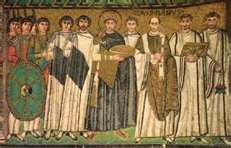|
The Emperor Diocletian was to erase civil war within Byzantium for the next thousand years but walked away from it all to become a cabbage farmer.
Emperor Constantinus I moved the seat of the empire to the ancient Greek city of Byzantion, and named the city Constantinopolis, meaning “Constantine’s city”. He brought senators and high level officials from Rome to establish a new administration, and he reconstructed the city and developed public facilities. Having also converted to Christianity, he made Constantinopolis a Christian city.

A shy, awkward, Pagan philosopher with no ambitions and no experience is appointed Caesar- Julian.
By the middle of the 5th Century the Roman Empire was on the verge of collapse. Its emperors were mere puppets, its armies were in chaos, and enemies were closing in on all sides. Unable to sustain itself, the West collapsed, plunging Europe into the Dark Ages. Then the unlikely savior of the Byzantine Empire comes- Zeno.
Emperor Justinian I (527–565) reconquered Northern Africa, Italy and Eastern Spain during his long rule, and secured the eastern territories. He also made considerable reforms in various areas, the most important of which was his codification of Roman law, which is generally accepted as having had a direct effect on the evolution of jurisprudence.

When Heraclius first came to the throne in 610, the Byzantine Empire was being attacked from numerous sides. In the west, the Avars and Slavs were expanding into the northern Balkans. The Slavs controlled the Danube regions, Thrace, Macedonia, and were soon invading Central Greece and the Peloponnesus.
In the east, meanwhile, the Persians under the rule of Chosroes had begun a series of successful attacks on the empire resulting in the loss of Damascus in 613, Jerusalem in 614 (destroying the Church of the Holy Sepulchre and capturing the Holy Cross) and Egypt in 619.

When the weak, ineffectual emperor Leo IV died in 780, he left the empire divided and in the hands of an orphan from Athens; the beautiful and grasping Empress Irene. 17 years later she was crowned as sole ruler after murdering her own son to take his place.
Basil I was hardly a promising candidate to usher in a new golden age to the Byzantine Empire. A poor, illiterate Armenian peasant, he was kidnapped by raiding Bulgarians as a boy, and only managed to escape in his mid twenties. Basil I was hardly a promising candidate to usher in a new golden age to the Byzantine Empire. A poor, illiterate Armenian peasant, he was kidnapped by raiding Bulgarians as a boy, and only managed to escape in his mid twenties.
When the 24 year old Alexius Comnenus came to the throne, the glories of the Empire seemed long gone. Its "invincible" army had been smashed at the battle of Manzikert, the frontiers were collapsing, and enemies on every side threatened to overwhelm what was left.
Isaac Angelus was never meant for the throne. He should have lived out his life in comfortable obscurity, but instead found imperial power thrust upon him as Alexius I's brilliant dynasty came to a bloody and decadent conclusion.
Constantine XI Paleologos, the last Emperor of the East Roman Empire, martyred by the forces of Sultan Mehmet during the assault on The City on May 29, 1453. Blessed Constantine, whose feast is celebrated on May 29 (e.g., St. Herman Calendar 2000, p.38), was a man whose personal life was marked by tragedy, but who above all maintained steadfast his Christian faith and his dedication to his duties as the Christian Emperor.
|

![]()


